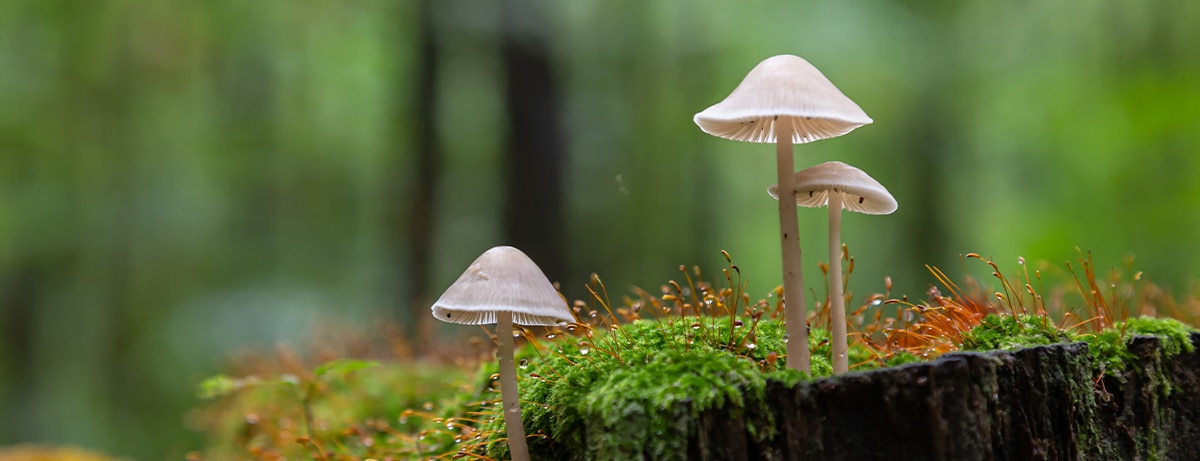15% off €25
Code:SPEND
Poisonous mushrooms to avoid

Foraging for mushrooms? Or simply curious about what fungi you can't eat? Discover what the most poisonous mushrooms are from our detailed list.
Summary
1How to identify poisonous mushrooms
There are thought to be over 14,000 species of mushrooms worldwide, but sadly, there is no standard identifier for poisonous mushrooms. It simply...
2Why are some mushrooms poisonous?
Mushrooms have evolved to develop mechanisms, like toxins, that help keep them alive so they can reproduce, much like many other plants and animals...
3What mushrooms are safe to eat?
Many mushrooms are healthy and delicious, with only 1-2% of mushrooms containing poisonous toxins.32 So rest assured that your favourite button...
Mushrooms have been foraged, cultivated, and used throughout history.1 But whilst these fungi make a great addition to many recipes, it's important to be cautious with some mushrooms, as not all are safe!
You should always be aware of poisonous mushrooms, as they can grow just about anywhere, including your garden lawn. In the UK, there are several dangerous mushrooms you should be on the lookout for, like the death angel mushroom and the death cap mushroom.
So, we've put together a helpful list of 10 of the most toxic mushrooms and tips on poisonous mushroom identification so that you can stay safe and informed.
10 poisonous mushrooms to avoid
Whether you’re looking to forage wild mushrooms or just want to learn more about these mysterious fungi, it’s wise to know which mushrooms are poisonous or even deadly, as mushrooms can grow in so many places, including your garden.
If you spot one of these poisonous fungi growing on your garden lawn, by your shed or in your borders, be careful! Remove and discard them carefully, especially if you have pets or children playing outside.2
Regardless of whether you’re out foraging or spotted a mysterious mushroom in your garden, here are 10 of the most poisonous mushrooms to know about:

1. Death cap mushrooms
This small, green-tinted mushroom might look innocent enough, but it is actually the most toxic mushroom worldwide and is responsible for the highest number of fatal mushroom poisonings across the globe.3
Death cap mushrooms, or Amanita phalloides, contain alpha-amanitin. This toxin can cause liver and kidney failure 6 to 24 hours after ingestion, and in fact, this mushroom is so deadly that eating just half a cap (the round top) can kill.4 These poisonous fungi grow on the ground in broadleaved woods, like those populated with oak and birch trees, and can often be found from August to November.5

2. Deadly webcap mushrooms
While these toxic mushrooms are rare in the UK, deadly webcap mushrooms are fatal, poisonous mushrooms responsible for many deaths in Europe. Sometimes confused for a chanterelle mushroom, deadly webcaps contain a poison called orellanine.6
Deadly webcap mushrooms, or Cortinarius rubellus, grow throughout August to November on the ground, amongst plants like heather, in coniferous pine or spruce forests. They have a unique pointed cap and are orange brown in colour.7

3. Destroying or death angel mushrooms
With their striking, pure-white appearance, you might be fooled into thinking these mushrooms are harmless, but they are highly poisonous and sometimes deadly.
Just one small piece of a death angel mushroom is enough to be fatal, and there is currently not thought to be an antidote.8
Death angel mushrooms, or Amanita virosa, contain deadly toxins which result in severe stomach pains and poisoning of the liver and kidneys between 8 and 24 hours after they’ve been consumed.9
These toxic mushrooms grow on the ground in broadleaved woods, particularly birch woods, from July to November. They also like to grow near oak trees too and could even pop up on your garden lawn.10

4. Fool’s conecap mushrooms
These small, cone-shaped, brown mushrooms are deadly poisonous, as they contain alpha-amanitin, which is toxic to your liver once ingested.
Fool’s conecap mushrooms, or Pholiotina rugosa, like to grow amongst leaf litter, rotting woodchip, sawdust, rich soil, and compost from July to October – so you could find these growing in your garden! They have small, smooth, and shiny caps that measure around 2cm across and flatten as it nears the edge.11

5. Funeral bell mushrooms
Poisonous and deadly, these little mushrooms definitely live up to their ominous-sounding name.
Whilst not overly common in the UK, these small but fatal mushrooms like to grow on dead, decaying wood on tree stumps or bark in coniferous woods from August to November and can still be found in areas of the UK where these conditions are met.12
Funeral bell mushrooms, or Galerina marginata, contain deadly amatoxins, the same toxins as in death cap mushrooms. If ingested, these toxins can make you sick, damage your liver and possibly result in death.13

6. Panther cap mushrooms
Beautiful but sinister, panther cap mushrooms are brown, spotty, and poisonous.
These spotted fungi cause intense sickness after you eat them and significantly affect the central nervous system. They can induce vivid hallucinations, confusion, visual distortion, delusions, and convulsions, which can sometimes be fatal.14
Panther cap mushrooms (Amanita pantherina) grow from July to November in broadleaved woods, particularly those with beech or oak trees. While uncommon in the UK, they can still develop if the right conditions are met, so keep an eye out!15

7. Angel’s Wings mushroom
Possibly one of the most striking-looking mushrooms out there, angel’s wings mushrooms (Pleurocybella porrigens) might look harmless but are actually quite poisonous.
These mushrooms are thought to contain toxic chemicals that can cause damage to your brain and possibly death.
Angel’s wings mushrooms are bracket fungi, as they have a unique shape that grows vertically up a tree. Bracket fungi, like angel’s wings mushrooms, can cause the trees they grow on to rot and decay, leading to the tree becoming weak and toppling or losing branches.16
These bracket fungi are bright white in colour and usually grow in clusters on decaying conifers. They grow throughout the autumn and mainly in the Scottish Highlands and Cumbria.17 They’re rare elsewhere in the UK, but if you do spot one, it’s best to leave it alone.

8. Deadly dapperling mushroom
Whilst it can be a rare find here in the UK, the deadly dapperling is one of the most poisonous lawn mushroom types as it likes to grow in grassy, open areas.
Their innocent-looking appearance means these toxic mushrooms sometimes get confused with other similar species, like the grey knight mushroom, which is actually edible.18
Their Latin name, Lepiota brunneoincarnata, can be interpreted in Greek as ‘scaly ear fungus’ – gross, we know.19 But the rounded cap of deadly dapperling mushrooms can sometimes resemble an ear, so perhaps this interpretation isn’t so far-fetched!
The deadly dapperling mainly grows across Europe and certain parts of Asia, and they have a lightly spotted cap that grows to around 2.5 to 6cm wide and a cream, narrow stem. The deadly dapperling mushroom is a toxic, poisonous species, as it contains large amounts of the toxin alpha-amanitin.20

9. False morel mushroom
Easily confused with the closely related and tasty morel mushroom, the false morel mushroom contains a deadly toxin, gyromitrin.
When broken down in the body, gyromitrin becomes monomethyl hydrazine. This toxic chemical is better known for its use in rocket fuel!21 Monomethyl hydrazine can have unpleasant effects on the central nervous system, resulting in neurological and gastrointestinal symptoms and even death.22
This rather strange-looking mushroom has a brain-like cap that ranges in colour from dark brown to orange brown. Unlike its friendly cousin, the false morel mushroom is not hollow in the middle and will have a strong smell. While uncommon in the UK, they can occasionally grow in wood debris beneath pine trees between March and May.23

10. Fly agaric mushroom
You’ll have definitely seen illustrations of these classic red and white mushrooms in your favourite storybook as a kid, but it turns out they’re pretty poisonous.
Often associated with fairies, gnomes and the like, these mushrooms are anything but magical, as they contain various toxic and psychoactive compounds that can have adverse effects when ingested.24
Fly agaric mushrooms (Amanita muscaria) are hard to miss with their bright red and white spotted cap and white gills. They’re large mushrooms, too, growing up to 30cm wide.
These poisonous mushrooms are native to the UK, growing in woodland and heathland in light soil. You’ll likely find them amongst birch, pine, or spruce trees from late summer to early winter.
How to identify poisonous mushrooms
There are thought to be over 14,000 species of mushrooms worldwide, but sadly, there is no standard identifier for poisonous mushrooms. It simply depends on the mushroom itself.25,26
If foraging for mushrooms is your thing (or you’d like it to be), there are some essential things to remember to make sure you avoid picking deadly mushrooms:
- Identify the mushroom correctly across multiple sources or with a professional. Otherwise, it’s best just to leave it alone.
- Make sure you have the proper permissions to forage in that specific area before you start filling your bag with wild produce.
- Avoid mushrooms with white gills, a skirt or ring on the stem, and a bulbous base.
- Steer clear of mushrooms that are red on the top of the stem, as these could be toxic.
Why are some mushrooms poisonous?
Mushrooms have evolved to develop mechanisms, like toxins, that help keep them alive so they can reproduce, much like many other plants and animals. It’s a way of defending themselves from being eaten by animals, insects, and us.27
The mushrooms you see in the ground are actually the fruiting bodies of the fungus, which release spores into the air. One mushroom can release a billion spores, but if the mushrooms are eaten, the spores are lost.28 So, these poisons are a defence mechanism to protect the mushroom and help the spores disperse for more mushrooms to grow.
Whilst some mushroom poisons might only make the eater sick or feel unwell, some can be fatal.29 However, many animals and insects have evolved to avoid toxic mushrooms, with scientists seeing that some snails avoid poisonous mushrooms altogether.30
Some animals, like household pets, may be attracted to some mushroom species due to their scent. But they should be kept away from mushrooms in case they ingest one they shouldn’t. If you suspect your pet may have eaten a toxic mushroom, you should immediately take them to the vet.31
What mushrooms are safe to eat?
Many mushrooms are healthy and delicious, with only 1-2% of mushrooms containing poisonous toxins.32 So rest assured that your favourite button mushrooms in your local supermarket are perfectly safe.
But there are so many exciting mushrooms that are entirely safe to eat and are great to add to your favourite recipes. These include:
- Shiitake mushrooms
- Reishi mushrooms
- Maitake mushrooms
- Portobello mushrooms
- Oyster mushrooms
- Lion’s mane mushrooms
The final say
Whilst there aren’t many mushrooms you can’t eat in the UK, it’s always important to keep an eye out for them to keep you, your family, and your pets safe when out and about.33
But poisonous mushroom identification can be challenging, so always make sure you’re 100% confident in what the mushroom is and that it is safe – especially if you’re out foraging. If you’re unsure what it could be, you should leave it alone – better to be safe than sorry!
- https://britishfoodhistory.com/2012/11/06/on-the-hunt-for-mushrooms/
- https://www.thespruce.com/how-to-get-rid-of-mushrooms-4706508
- https://www.britannica.com/science/death-cap
- https://www.britannica.com/science/death-cap
- https://www.wildfooduk.com/mushroom-guide/deathcap/
- https://www.first-nature.com/fungi/cortinarius-rubellus.php
- https://www.wildfooduk.com/mushroom-guide/deadly-webcap-2/
- https://www.first-nature.com/fungi/amanita-virosa.php
- https://www.uaex.uada.edu/yard-garden/resource-library/plant-week/death-angel-mushroom.aspx
- https://www.wildfooduk.com/mushroom-guide/destroying-angel/
- https://www.inaturalist.org/taxa/179219-Conocybe-filaris
- https://www.first-nature.com/fungi/galerina-marginata.php
- https://www.wildfooduk.com/mushroom-guide/funeral-bell/
- https://www.mushroom-appreciation.com/angel-wings-identification.html
- https://www.first-nature.com/fungi/amanita-pantherina.php
- https://www.rhs.org.uk/biodiversity/bracket-fungi
- https://www.wildlifetrusts.org/wildlife-explorer/fungi/angels-wings
- https://inaturalist.nz/taxa/515954-Lepiota-brunneoincarnata
- https://www.first-nature.com/fungi/lepiota-brunneoincarnata.php
- https://pubmed.ncbi.nlm.nih.gov/20870578/
- https://www.chemeurope.com/en/encyclopedia/Monomethylhydrazine.html
- https://nj.gov/health/eoh/rtkweb/documents/fs/1265.pdf
- https://www.wildfooduk.com/mushroom-guide/false-morel/
- https://www.woodlandtrust.org.uk/trees-woods-and-wildlife/fungi-and-lichens/fly-agaric/
- https://www.micropia.nl/en/discover/microbiology/mushroom/
- https://www.wildfooduk.com/articles/how-to-tell-the-difference-between-poisonous-and-edible-mushrooms/
- https://pubmed.ncbi.nlm.nih.gov/16475091/
- https://www.britannica.com/video/81494/spores-Fungi-billions-fungi-rise-generations
- https://doi.org/10.1007/BF00988513
- https://doi.org/10.1016/0031-9422(95)00773-3
- https://www.petmd.com/dog/poisoning/mushroom-poisoning-in-dogs
- https://www.mushroomthejournal.com/greatlakesdata/TopTen/Quest19.html
- https://www.gov.uk/government/news/take-care-when-picking-mushrooms-poisons-experts-warn






